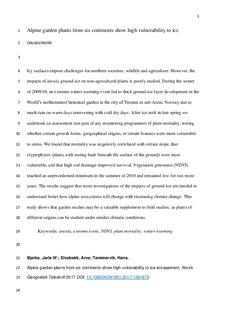| dc.description.abstract | Icy surfaces impose challenges for northern societies, wildlife and agriculture. However, there have been relatively few studies of the impacts of anoxic ground ice on non-agricultural plants. During the winter of 2009–2010, an extreme winter warming event led to thick ground-ice layer development in the world’s northernmost botanical garden in Tromsø, in subarctic Norway, due to much rain on warm days interspersed with cold dry days. After ice melt in late spring, the authors assessed plant mortality and tested whether certain growth forms, geographical origins, or terrain features were more vulnerable to stress. They found that mortality was negatively correlated with terrain slope, that cryptophytes were most vulnerable, and that good soil drainage improved all plants’ survival. Vegetation greenness (measured by the Normalized Difference Vegetation Index, NDVI) reached an unprecedented minimum in the summer of 2010 and remained low for two more years. The results suggest that more investigations of the impacts of ground ice are needed to understand better how alpine ecosystems might change with increasing climate change. In conclusion, the study revealed that botanical garden studies may be a valuable supplement to field studies, as plants of different origins could be studied under similar climatic conditions. anoxia, extreme event, NDVI, plant mortality, winter warming | nb_NO |
